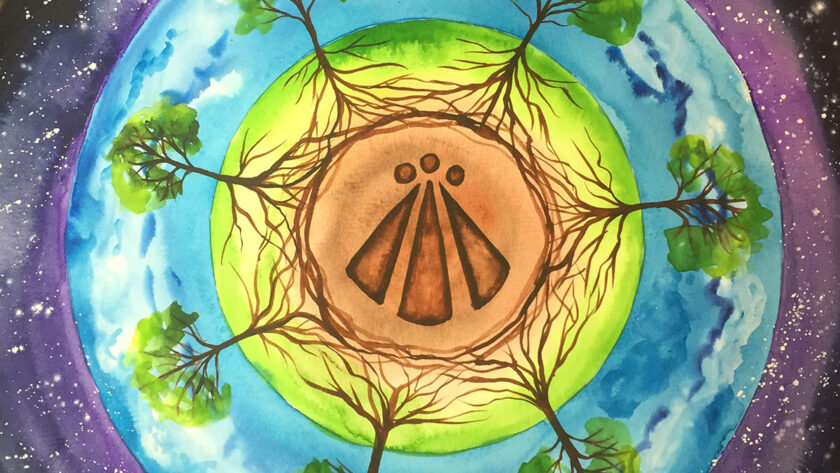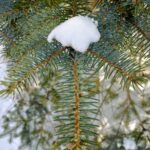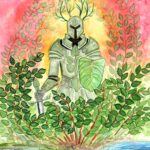This is my song, this is my voice,
These are my words, this is my choice.
Hear me now, take heed of my words.
Love me now, and your spirit will fly.
Hear me in the howling of the wolf,
My voice is the song of the Bards,
I am the power that helps the salmon leap,
I am the very first breath of a child.
From Damh the Bard’s Song of Awen.
It has been a long journey in considering the role of the bardic arts in the druid tradition and the role that creativity plays in spirituality. I realized that one final thing was missing from our discussion–a set of practical exercises and rituals that you can use to better work with the flow of awen and embrace the path of the bard. And so, to finish out my long series on the Bardic Arts in the Druid Tradition, we turn today to some practical rituals and practices that you can engage in to help cultivate your own bardic practice. If you haven’t read the other posts in this series, you might want to start there. They are, in order: the cultivation and flow of awen, cultural challenges surrounding taking up the path of the bard, tips for how to cultivate the bardic arts, the fine art of creating functional things, and finally, the bardic arts as a path of spiritual development. And so today, we look at five practices that can help you further cultivate the bardic creative arts in your life and in the lives of others: the bardic circle/Eisteddfod, a bardic storytelling ritual, a ritual for invoking the awen, setting up a magical creative working space, and a ritual for cultivating the bardic arts. I hope that these suggestions offer you some practical tools as you continue on your own path of the bard and embrace the creative flow of awen in your life!
Hosting a Bardic Circle or Eisteddfod
In the modern druid tradition, an Eisteddfod is a circle of bards who come together to share tales, stories, dances, and more. We use this term more loosely in the druid community than where it originated historically, and to frame this practice, understanding a bit about the Welsh Eisteddfod is necessary. Welsh Eisteddfods are traditional bardic arts competitions that have been has been held on a national level in Wales since the 18th century, but go back in various forms much further than that. One of the key early figures in the druid revival, Iolo Morganwg, took the Eisteddfod a bit further. He developed a “Gorsedd,” which was an event within the Eisteddfod that offered various degrees, ritual and ceremony for the for the purpose of promoting excellence in the bardic arts, particularly poetry, music, and literature. To this day the Welsh Gorsedd has druids, bards, and ovate who wear various robes. The ranks of the bards include individuals who sit for exams in a variety of bardic arts, Welsh language, and more. Ovates and druids are honored for their contributions to Welsh Culture. Both of these practices persist to this day in Wales, and they take on a particular flavor in the modern Druid communities that trace their roots to the druid revival.
In modern Druid communities, it is very common to experience an Eisteddfod, sometimes simply for sharing, and other times, for a bardic arts competition. Most typically, the bardic circles happen around campfires and can last into the wee hours of the morning. Sometimes, the Eisteddfod is setup as a formal competition with multiple rounds, winners of individual rounds get to compete at the final night of the gathering. The winner gets a prize, or at least, serious community recognition. But also, just as often, there is no competition and instead, it is a chance simply to share something by the fire: a poem, a story, a song, . Sharing at an Eisteddfod does not come easily to many people due to a lifetime of cultural conditioning, however, sharing at an Eisteddfod allows you to break the potential years of silence and thinking you aren’t good enough and again realize there you are, telling a tale and hearing a thunderous applause.
Starting an Eisteddfod: You can start an Eisteddfod with friends (including non-druid friends). Ideally, you need a circular space where people can gather and enough people to make it a good time. A campfire or fireplace to gather around is a plus, but not necessary. Consider having a potluck meal as part of your Eisteddfod.

A Simple Setup. For an Eisteddfod, you need a space where people can gather, enough people to share stories, songs, dances, and other creative expressions, and some libations and food. A fire is a bonus, but is by no means necessary. You also need a master of ceremonies of sorts to help keep things going. If you are doing an actual competition, you need two additional things: a panel of judges who will be able to declare winners and prizes for the winners.
The best part about an Eisteddfod don’t need to invite “druids” over or people on a similar spiritual path. Every day folks from a variety of different traditions and life paths might find the idea of the Eisteddfod appealing and join your circle of bards. It is a good way for solitary druids to find community without other druids nearby and still engage in a core practice in the druid tradition.
A Bardic Storytelling Ritual of Empowerment
The stories of our own past and histories can help shape our present understanding. This ritual is performed by two people. It can be performed in a sacred space, around a fire, or over a period of days where two people are spending them together. In this ritual, we use the bardic art of storytelling to share stories that are themed through one of four Jungian archetypes (the hero, caregiver, magician, and bard). The two people take turns telling their stories, and while one is telling the tale, the other is deeply listening. At the end of the tale, the listener shares the deeper qualities that he/she heard. For example in a tale of the hero, the listener might hear that the speaker showed bravery, quick-wittedness, and eloquence. The goal of this storytelling ritual is to allow both participants to recognize the other’s gifts, the things that are already within ourselves, and that we may want to further cultivate. Write down the qualities that the listener tells you for each of the stories—they are qualities to remember, and draw upon, for our own healing and growth.
The following four archetypes can be used:
- The Hero (a person who employs courageous acts)
- The Caregiver (a person who protects and cares for others)
- The Bard (a person who realizes a creative vision)
- The Magician (one who is able to work magic)
Other possibilities that you might want to include beyond the original three.
- The Explorer (one who goes on a journey)
- The Lover (one who expresses deep love for another)
- The Sage (a person who seeks truth and deeper self awareness)
- The Ruler (one who helps lead others)
Ritual for Invoking Awen
This very simple ritual for invoking Awen connects us deeply with the waters and the flow of Nywfre. You can use it at the start of any creative endeavor.
Supplies: Sacred Water. Before you can do this ritual, you will need to gather some water from a place sacred to you. Natural springs or wells are particularly effective for this, as is rainwater. If you are home-bound, even getting a bottle of fresh spring water from a local source will be effective here. Once you have your water, you can “make more” sacred water for this ceremony by simply adding new water (of any kind) to it. This water can also be used in your elemental altar, below. Place the sacred water in a small glass bowl and have it available for the ritual.

The Ritual: Begin by taking three or more deep breaths, settling yourself into your body and allowing your breath to center and calm you. When you are ready, close your eyes and ring out the “Awen” chant three times. Then, with the bowl of sacred water, lathe your brow and your hands, and say “May the Awen flow within me. May the muse inspire me.” Take a moment to visualize the flow of the Awen within you, flowing in from the land, sea, and sky.
Setting up a Magical Creative Working Space: A Bardic Altar
Setting up Your Altar
We can use the elemental systems present in the druid tradition to help cultivate the right kind of energy for our own creative workings. One very effective way of doing this is to draw upon the power of the elements to create a physical shrine dedicated to helping you with your creative bardic arts.
For the bardic arts, we might use a four-fold elemental system as follows:
- Fire – Beginning projects, gathering steam, projects of passion and intensity, any body-based work
- Materials for Altar: Candles, igneous rocks, plant material that likes to burn (like white birch, conifers), red altar cloth, images of fire/sun/light
- Air – Projects that require deep and clear thinking, projects that are mind/language/communication/memory based, writing/poetry/songwriting projects, problem solving
- Materials for Altar: Incense, white/light gray/light yellow altar cloth, feathers, wind chimes, bells, singing bowls, images of the sky and clouds
- Water – Building positive emotions towards a project, overcoming challenges, allowing the Awen to simply flow through you, any painting-based work (watercolor), other work that requires flow and fluidity (like dance)
- Materials: Bowl of water, collection of water from sacred places, shells, river stones, opals, blue altar cloth, images of water/rivers/lakes, lake plants, seaweed/lake weed
- Earth – Continuing on with a longer project that you are growing weary of, stubbornness and determination, also any wood-based work or earth-based work (clay), any nature-themed work
- Materials: Stones, roots, nuts, fruit, bowl of earth, brown or green altar cloth, bark, images of caves and mountains
You can create a small elemental altar near where you are working on your bardic arts to help bring in that elemental energy to the space. You can change the “focus” of the altar based on what elemental energy you might need at the moment for your work. An altar cloth and change of materials will allow you to always bring in the blessing of the element.
For example, I have a permanent elemental altar on a shelf in my art studio. While all of the elements are present, the major focus of the altar rotates based on the project I’m working on. If I am particularly deficient and having difficulty (for me, this is almost always in earth and maintaining my focus on a longer project over time) I will dedicate the entire altar space to the energies of the earth for that purpose. And so, I gather up things that are representative of the earth: leaves, acorns, roots, soil, and a potted plant and bring them into the altar. I also include a small bowl of water, incense, and a candle to represent the other elements (as their presence is also needed for any project to come into manifestation). Finally, I include an awen symbol on the altar to recognize and connect with the divine inspiration that drives the creative work.
In addition to the elements, you might want to put other pieces on the altar that are dedicated to your particular bardic arts. For example, if you are working on writing, an old-style pen and inkwell might be appropriate, or a symbol fo Mercury, who governs communication. If you are a dancer, an old pair of dance shoes and a photo of a dancer who inspires you would be appropriate, and so on.

Another option if you don’t have space for an altar or you don’t have a dedicated bardic arts space (or it isn’t appropriate due to living circumstances) is to hang an elemental representation (or set of representations) somewhere near where you practice your bardic art. So if you practice your storytelling in front of the mirror in the bathroom, hang up a painting or photo of the element(s) or a natural place that is strongly aligned with that element that will aid you. You could also use a simple awen drawing for this purpose.
Using Your Altar
You can use the altar in a variety of ways. The presence of the altar itself will have benefits on the bardic work. Pausing before you begin the work to open up a sacred space (see below) using the altar as a focus is also a useful practice. Tending the water regularly (changing the bowl of water, regular adding of new things, dusting, etc.) also connects you to that bardic practice. Even if you don’t have time to engage in your bardic arts that day, visiting the altar and offering an awen chant will continue to encourage the flow of awen in your life.
Before you begin to do magical crafting or practice your bardic art, you can use the altar as a focus point to open up a sacred bardic grove, which I’ll now discuss.
Opening up a Sacred Bardic Arts Space
As the druid tradition recognizes that the bardic arts are inherently connected to spiritual practice, you can create a sacred space in which to engage in your bardic arts by using a simple sacred grove opening. This practice is particularly effective if you are working on a project that is new, challenging, or spiritual in nature.
This could be very simple:
- Declaring that you are opening a space for working in your bardic art
- Declaring peace in the quarters
- Drawing upon the four elements for strength (see below)
- Asking the Awen to flow within (see below)
- Putting up a sphere of protection (AODA) or a simple protective circle (OBOD) for the duration of your crafting experience.
Here is some elemental invoking language you can use:
- May the blessings of the Air inspire me and give me focus and clarity for my creative work.
- May the blessings of Fire inspire me and give me passion and creativity for my creative work.
- May the blessings of Water inspire me and allow the work to flow.
- May the blessings of Earth inspire me and give me grounding and strength.
You can also get more specific with the language based on the bardic art.
To invoke Awen, yo might use a simple poem:
I call upon the Awen, the ancient source of divine inspiration,
I call upon the muses, the hallowed ones who guide my hand/voice/body
[as appropriate]
I call upon the living earth, the force of nature that inspires my craft.
I call upon my ancestors, whose creativity flows within me.
[Add any additional calls as is appropriate]
May the blessing of the awen flow within me this day and always.
And with that, you can open your sacred space for creating the bardic arts, and leave it open as long as you plan on working that day.




Reblogged this on Paths I Walk.
Thank you for the reblog!
Hi Dana,
I have really enjoyed reading your posts on Bardic Creativity. I am interested in this,
Blessings,
Kathleen
Hi Kathleen,
I’m glad you enjoyed the Bardic Arts series! I’ll be continuing with the druid and ovate arts here in a bit after covering some other material. Blessings!
Reblogged this on Rattiesforeverworldpresscom.
Thanks for the reblog!